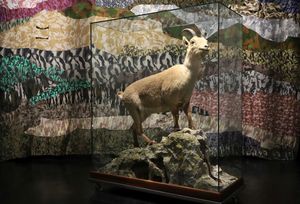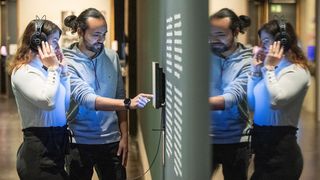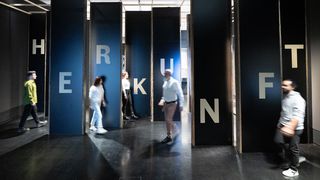About the Exhibition
Curator & Project manager: Dr. Viktoria Krason, DHMD
Scientific & Curatorial Associate: Nele-Hendrikje Lehmann
Curatorial & Project Assistance: Bettina Beer
Exhibition Design: Jan Pappelbaum, Berlin
Around the year 2000, it looked as if the secret of life might slowly but surely be revealed. Indeed, it seemed only a matter of time before our genetic makeup would be decoded by the Human Genome Project; and Dolly the sheep had been successfully cloned. For some, it meant that the ability to combat previously incurable diseases was now within reach; others felt that ominous science fiction scenarios were becoming reality. Has anything in this constellation changed since then?
Well, in recent decades, genetic research has yielded new knowledge and some fascinating new technologies, from the sequencing of the Neanderthal genome to the CRISPR-Cas9 gene scissors and modern mRNA vaccines. While not all our future expectations have been fulfilled, these advances are certainly poised to shift our understanding of our origins, identity and health. And they are influencing the way we see the place of human beings in nature. So how critical do we need to be in our approach to these achievements and their possible repercussions? Is what is technically feasible also what is ethically acceptable? And has the danger of a racist instrumentalisation of genetics been banished forever?
The exhibition ‘Of Genes and Human Beings’ took a serious and consistent look at the insights gained in science laboratories from the perspective of the social and cultural sciences: with exhibits from everyday life and science, culture and history, the approaches of contemporary art – and with interactive stations that invited us to find out for ourselves who we are and who we might become.
Gallery
Exhibition Sections
![[Translate to English:] Spirometer](/fileadmin/_processed_/2/9/csm_1_Spirometer_fd51b8595a.jpg)
I. Our origins – Humanity’s history
How much of us is in our DNA? Our genetic code alone does not account for our personality. That’s why identical twins for example, whose genome is virtually identical, can develop in quite different ways later in life. In recent years, the scientific discipline known as epigenetics has sought to explain why this is so. The reasons appear to lie in the complex interaction between genes, proteins and environmental influences.
Photo:
Spirometer for Measuring Lung Capacity with “race correction”
SPIROMATE AS-300 Riko, 1980s
Spirometers measure lung capacity. To exclude deviations due to size, gender and age, corresponding information is typed into the device. It is also possible to note ethnicity. Some physicians still assume Blacks have a lower lung capacity than Whites. However, this supposition from the 19th century has not been genetically proven.
![[Translate to English:] Candice Breitz: „Factum Tremblay“, 2009](/fileadmin/_processed_/0/a/csm_2_Candice_Breitz_Factum-Tremblay_e179ba612b.jpg)
II. Identity – What determines who we are?
What does our DNA tells us about us? Today, genetic analyses can reveal a great deal: they help us to solve criminal cases and better understand diseases. We can even reconstruct the history of humankind more accurately by examining prehistoric genetic material. DNA tests are now also used for personal genealogical research – and not just in the United States. Research into genetic differences has always influenced whether we see ourselves as members of the great human family or of discrete and definable groups.
Photo:
Candice Breitz: „Factum Tremblay“, 2009
From the series „Factum“, 2010, Commissioned by The Power Plant, Toronto, Courtesy: Goodman Gallery, London + Johannesburg
In her video work Candice Breitz talks to monozygotic twins and asks them the same questions, but separately. The individual personal development of those portrayed thus becomes the focal point.
![[Translate to English:] Alicja Kwade: „Principium“, 2021/2022](/fileadmin/_processed_/8/d/csm_3_Alicja_Kwade_Principium_1_32143339c1.jpeg)
III. Health – To heal, optimise or standardise?
What happens when we alter our DNA? Genetics has opened up completely new possibilities for medicine to identify diseases, cure them or exclude them right from the outset. Today, the CRISPR-Cas9 gene scissors allow us to make targeted changes in the germline of embryos; in Germany, however, such changes remain prohibited. After all, can we even begin to get a sense of the possible risks of such procedures?
Photo:
Alicja Kwade: „Principium“, 2021/2022
Courtesy of the artist
Photo: Roman März

IV. Nature – A new creation?
What is it that actually connects human beings with other animals? Can we reverse the process of species extinction (which we ourselves have triggered) by bringing now extinct species back to life? What other contemporary global crises could genetic engineering influence? And how would this affect our own position within nature? The exhibition culminates in an open space of possibilities dedicated to contemporary artistic takes on these issues.
Photo:
Christian Kosmas Mayer: The last bucardo, 2023
Christian Kosmas Mayer in cooperation with Phileas and in collaboration with Adam Searle; Lenders for parts of the work: Gobierno de Aragón / Parque Nacional de Ordesa y Monte Perdido; Centro de Investigación y Tecnología Agroalimentaria de Aragón (CITA); with inclusion of a work by Catrin Bolt
In 2003, the Pyrenean ibex, or bucardo, became the only extinct animal species to be brought back to life – with the help of genetic engineering. The animal, cloned from cryopreserved cells, lived for seven minutes. Mayer’s installation uses material evidence to correlate the locally anchored cultural history of the bucardo with the story of its short-lived revival.

Funded by


Scientific Supervision & Consulting
Prof. Dr. Ken Arnold, Prof. Dr. Frank Buchholz, Sascha Karberg, Prof. Dr. Johannes Krause, Prof. Dr. Thomas Lemke, Prof. Dr. Veronika Lipphardt, Prof. Dr. Peter Pfaffelhuber, Dr. Kai Prüfer, André Raatzsch, Dr. Robert Ranisch, Prof. Dr. Gudrun Rappold, Anja Reuss, Prof. Dr. Hans-Jörg Rheinberger, Prof. Dr. Volker Roelcke, Prof. Dr. Eleanor Scerri, Dr. Stephan Schiffels, Prof. Dr. Christian Schwarke, Dr. Mihai Surdu, Dr. Katrin Vohland, Prof. Dr. Claudia Wiesemann












